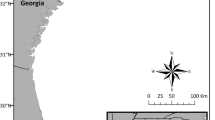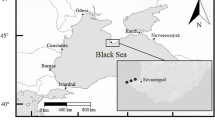Abstract
Krill (Euphausia superba Dana), the dominant member of the Zooplankton community of the Southern Ocean, has been the subject of study for many years. As the main prey species of the baleen whales, several species of seals and many sea bird, fish and cephalopod species, its importance within the ecosystem is clear. It is important for the practicalities of management of the Southern Ocean to estimate the ability of krill to sustain a harvest by man or by its natural predators1,2. This estimation requires a knowledge of growth and longevity3,4, which in krill are the subject of some controversy. Conflicting results have been obtained from krill size composition analysis, which indicates a short lifespan, and age pigment analysis, which indicates a longer life. Here we have analysed eight years of data on krill taken between 1928 and 1938 and have obtained estimates which consistently indicate high growth rates, modulated by a strong seasonal pattern. The cumulative growth through the year is therefore consistent with the studies of age structure using pigment analysis.
Similar content being viewed by others
References
Laws, R. M. Phil. Trans. R. Soc. Land. B279, 81–96 (1977).
Beddington, J. R. & de la Mare, W. K. in Marine Mammals and Fisheries (eds Beddington, J. R., Beverton, R. J. H. & Lavigne, D. M.) 94–105 (George Allen & Unwin, London, 1985).
Gulland, J. A. F.A.O. Fish. Biol. Tech. Pap. 97, 1–425 (1970).
Beddington, J. R. & Cooke, J. G. F.A.O. Fish. Biol. Tech. Pap. 242, 1–47 (1983).
Ruud, J. T. Halvråd. Skr. Oslo 2, 1–105 (1932).
Bargmann, H. E. Discovery Rep. 23, 103–176 (1945).
Marr, J. Discovery Rep. 32, 33–464 (1962).
Makarov, R. R., Naumov, A. G. & Shevtsov, V. V. in Antarctic Ecology Vol. 1 (ed. Holdgate, M. W.) 173–176 (Academic, London, 1970).
Ivanov, B. G. Marine Biol. 7, 340–351 (1970).
MacKintosh, N. A. Discovery Rep. 36, 1–94 (1972).
MacKintosh, N. A. Discovery Rep. 36, 95–156 (1973).
Ettershank, G. Polar Biol. 2, 189–193 (1983).
Ettershank, G. J. Crustacean Biol. 4 (Spec. No. 1), 295–305 (1984).
Clark, A. Mar. Biol. A. Rev. 21, 341–453 (1983).
Bucholtz, F. in Antarctic nutrient cycles and food webs (eds Siegfried, W. R., Condy, P. R. & Laws, R. M.) 339–345 (Springer, Berlin, 1985).
Ikeda, T. & Dixon, P. J. exp. mar. Biol. Ecol. 62, 143–151 (1982).
Shepherd, J. G. in The theory and application of length based methods of stock assessment. (eds Pauly, D. & Morgan, G. P.) Section 1 (ICLARM Conference Series, Manila, in the press).
Shepherd, J. G. in The theory and application of length based methods of stock assessment (eds Pauly, D. & Morgan, G. P.) Section 2 (ICLARM Conference Series, Manila, in the press).
Morris, D. J. & A. Keck Meeresforschung 30, 94–100 (1984).
Basson, M., Rosenberg, A. A. & Beddington, J. R. (manuscript in preparation).
Author information
Authors and Affiliations
Rights and permissions
About this article
Cite this article
Rosenberg, A., Beddington, J. & Basson, M. Growth and longevity of krill during the first decade of pelagic whaling. Nature 324, 152–154 (1986). https://doi.org/10.1038/324152a0
Received:
Accepted:
Issue Date:
DOI: https://doi.org/10.1038/324152a0
- Springer Nature Limited
This article is cited by
-
An Antarctic krill (Euphausia superba) hotspot: population characteristics, abundance and vertical structure explored from a krill fishing vessel
Polar Biology (2015)
-
Moult in relation to some aspects of reproduction and growth in swarms of Antarctic krill,Euphausia superba
Marine Biology (1996)
-
Age determination of Antarctic krill using fluorescence and image analysis of size
Polar Biology (1989)
-
Age and growth of Antarctic Euphausiacea (Crustacea) under natural conditions
Marine Biology (1987)
-
Moulting interval and growth of juvenile Antarctic krill (Euphausia superba) fed different concentrations of the diatom Phaeodactylum tricornutum in the laboratory
Polar Biology (1987)





